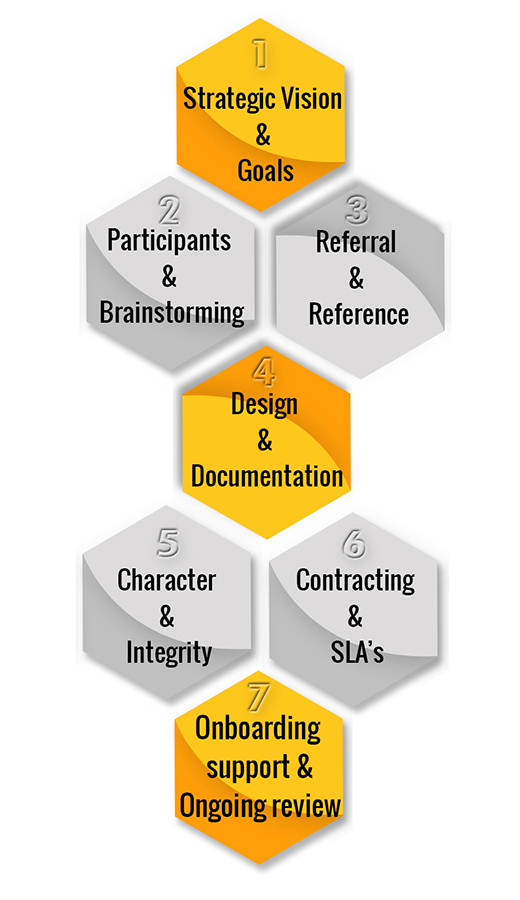When it comes to choosing business partners, choose carefully. Your brand and reputation are at stake. Before deciding to partner, first answer some fundamental questions:
- What are you are trying to achieve?
- Can you work with current processes, people, and budget requirements?
- Why is it important to partner?
Once you answer these basic questions, you’ll be in a better position to take next steps to select the right partner for your business needs. The following are some of the key elements to consider when picking the right vendor partners for your business.
-
Strategic Vision and Goals
First, define the desired organization, capability, and scope of the vendor partner. The vision should be created with the input of all key stakeholders (e.g., business units, finance department, legal and compliance, etc.).
Setting goals is an ideal way to offer direction, focus, and motivation. The first step in achieving them is defining them. Goals should be specific and realistic. Sometimes it helps to breakdown your goals into smaller incremental steps and prioritize them accordingly. Make sure you have the required resources and support to achieve your goals.

-
Participants and Brainstorming
It is critical to keep partnership projects within a smaller group so as not to disrupt the existing process if not carried out appropriately and in a timely manner. Accept input from leadership, process owners, and middle management because it can provide perspective on the overall elements of the project.
Do some brainstorming on your own. Come up with problems and ideas on solving them before presenting them to others. Preparing on your own will help facilitate discussion with teammates and offer pros and cons to each solution option. This makes for better decision-making.
-
Referral and Reference
Recommendations are an essential part of identifying the right partners. Ask colleagues from within and outside your organization. Referrals can help facilitate introductions to persons and firms that have a reputation for being skilled at solving problems like your own. It’s a plus to be referred to someone who already has a working relationship with the same partner you’re assessing. It provides assurance to the services and deliverables, confirms understanding of the overall problem and expected outcome, and affords the opportunity to challenge claims made by the potential vendor-partner.
-
Design and Documentation
It is important to document the expectations, roles and processes clearly. It prevents ambiguities as to the requirements and an affirmation of understanding minimizes the chance the project’s timeframe will be delayed. Upon sharing the expectations with the potential vendor partners, allow them to review and ask questions for clarification before they submit a proposal.
-
Character and Integrity
It goes without saying that one of the most important points to consider when picking the right partner includes moral character. Honesty and Integrity are fundamental values that can be recognized in face-to-face meetings when evaluating a new partner.
-
Contracting and SLA’s
During this stage, review meetings should be conducted with vendor partners. The meetings should be held with appropriate attendees from process, legal, finance, etc. Make sure the contract is negotiated so that both parties win. One-sided contracts tend to be short-lived and counterproductive when looking to achieve lasting results. Cover all critical SLAs, KPIs, business requirements, IT/security requirements, pricing, dates, and exit clauses.
-
Onboarding Support and Ongoing Review
Mutual agreement between both parties is the cornerstone of a successful contract. The vendor partner cannot be successful unless they are provided all required support and information to perform their services. Invest time during the implementation and onboarding process. The review meetings should be held on a regular schedule (i.e., once a week, month, quarterly, half yearly or yearly), depending on the strategy and client expectations. The agenda of these meetings should include the following points:
- Discussion of performance against metrics
- Action points from previous review meetings
- Areas of improvement
- Support needed to drive project improvement, etc.
A Vee Healthtek Case Study
The client is a mid-size hospital on the East coast, in contract with a vendor partner for coding services, which provided several contract coders to manage their hospital charts. The client had several operational, delivery and financial issues with the partner, but was unable to break their ties because of contractual obligations. This negatively impacted the client in the areas of:
- Coding accuracy – poor quality of work impacted the reimbursement and revenue loss
- Staffing – due to contractual nature of the coders, there was inconsistency in staffing; charts were not coded in timely fashion which inflated the DNFB and created backlog
- Pricing – no cost savings were appreciated because of performance issues
- Billing inaccuracies – inflated invoices did not reconcile with work delivered
- Overtime and consulting fees – client was invoiced for some additional overtime and consulting fees with no written approval or agreement
- Contractual issues – onerous termination clause; client was contractually obligated to pay significant penalty if failed to provide termination notice of almost 12 months
Solution
- Hospital hired a new executive and leadership team to manage the project
- Hospital performed detailed review of the existing contract, operations and vendor partner
- Detailed report was submitted to the board
- New leadership team worked with their legal team and partners on the termination clause. Developed a minimum impact solution and a termination clause was put in motion immediately
- New RFP was rolled out and Vee Healthtek was invited through a client referral
- RFP team thoroughly defined roles, responsibilities and expectations in the RFP
- Vee Healthtek went through rigorous screening, negotiation and reference check process to win the RFP
Vee Healthtek’s Approach, Focusing On
- Cost savings – provided certified offshore coders with onshore support, helping client to see immediate cost savings
- Pricing model - flexible pricing model allowed client to pay for only charts coded and completed by Vee Healthtek’s team
- Implementation team assigned; Vee Healthtek invested in sending team of coders onsite to learn the systems and process, to review existing coding process and guidelines, and recommend changes to meet coding compliance
- Dedicated team of experienced coders was assigned
- Additional coders on board from beginning to clear the backlog
- Overtime to manage backlog, planned with client approval
- Team working on all major U.S. and Indian holidays
- Quality reports provided; worked with client supervisors and manager to establish ongoing quality process
- Manual reports produced as Vee Healthtek and client worked on system challenges
- SLA's – a weekly review call established to monitor and gauge Vee Healthtek’s performance
Before Vee Healthtek Going LIVE

8 weeks after Vee Healthtek Going LIVE

As the charts indicate, Vee Healthtek cleared the outpatient chart backlog and improved the DNFB of inpatient records in six weeks after going live. Vee Healthtek exceeded quality expectations, scoring above 96% accuracy on the audit performed by external auditors.
As this case study demonstrates, there is a tried and true method of choosing the right business partner. And when that choice is made and executed correctly, amazing things can happen.

